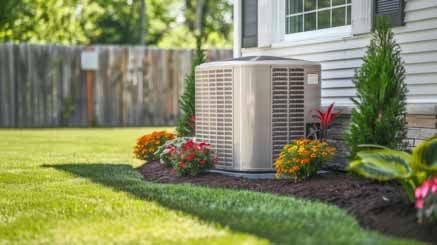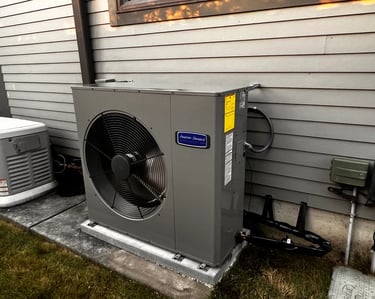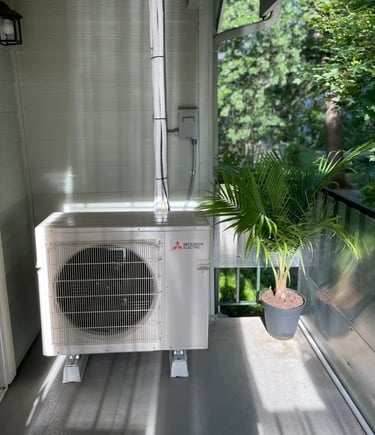The History of Heat Pumps
Learn more about the Heat pump system, how it works and how evolved in time. Few things you might be interested before starting the change so yo can be prepared for everything.
INFORM YOURSELF


A heat pump is a device that uses electricity to transfer heat from a colder place to a warmer place. Specifically, the heat pump transfers thermal energy using a heat pump and refrigeration cycle, cooling the cool space and warming the warm space.[1] In winter a heat pump can move heat from the cool outdoors to warm a house; the pump may also be designed to move heat from the house to the warmer outdoors in summer. As they transfer heat rather than generating heat, they are more energy-efficient than heating by gas boiler.[2]
A gaseous refrigerant is compressed so its pressure and temperature rise. When operating as a heater in cold weather, the warmed gas flows to a heat exchanger in the indoor space where some of its thermal energy is transferred to that indoor space, causing the gas to condense into a liquid. The liquified refrigerant flows to a heat exchanger in the outdoor space where the pressure falls, the liquid evaporates and the temperature of the gas falls. It is now colder than the temperature of the outdoor space being used as a heat source. It can again take up energy from the heat source, be compressed and repeat the cycle.
Air source heat pumps are the most common models, while other types include ground source heat pumps, water source heat pumps and exhaust air heat pumps.[3] Large-scale heat pumps are also used in district heating systems.[4]
Because of their high efficiency and the increasing share of fossil-free sources in electrical grids, heat pumps are playing a role in climate change mitigation.[5][6] Consuming 1 kWh of electricity, they can transfer 1[7] to 4.5 kWh of thermal energy into a building. The carbon footprint of heat pumps depends on how electricity is generated, but they usually reduce emissions.[8] Heat pumps could satisfy over 80% of global space and water heating needs with a lower carbon footprint than gas-fired condensing boilers: however, in 2021 they only met 10%.
A: indoor compartment, B: outdoor compartment, I: insulation, 1: condenser, 2: expansion valve, 3: evaporator, 4: compressor
Main articles: Heat pump and refrigeration cycle and Vapor-compression refrigeration
Heat flows spontaneously from a region of higher temperature to a region of lower temperature. Heat does not flow spontaneously from lower temperature to higher, but it can be made to flow in this direction if work is performed. The work required to transfer a given amount of heat is usually much less than the amount of heat; this is the motivation for using heat pumps in applications such as the heating of water and the interior of buildings.
The amount of work required to drive an amount of heat Q from a lower-temperature reservoir such as ambient air to a higher-temperature reservoir such as the interior of a building is:where
is the work performed on the working fluid by the heat pump's compressor.
is the heat transferred from the lower-temperature reservoir to the higher-temperature reservoir.
is the instantaneous coefficient of performance for the heat pump at the temperatures prevailing in the reservoirs at one instant.
Principle of operation:
The coefficient of performance of a heat pump is greater than one so the work required is less than the heat transferred, making a heat pump a more efficient form of heating than electrical resistance heating. As the temperature of the higher-temperature reservoir increases in response to the heat flowing into it, the coefficient of performance decreases, causing an increasing amount of work to be required for each unit of heat being transferred.
The coefficient of performance, and the work required by a heat pump can be calculated easily by considering an ideal heat pump operating on the reversed Carnot cycle:
If the low-temperature reservoir is at a temperature of 270 K (−3 °C) and the interior of the building is at 280 K (7 °C) the maximum theoretical coefficient of performance is 28. This means 1 joule of work delivers 28 joules of heat to the interior. The one joule of work ultimately ends up as thermal energy in the interior of the building and 27 joules of heat are moved from the low-temperature reservoir.
As the temperature of the interior of the building rises progressively to 300 K (27 °C) the coefficient of performance falls progressively to 10. This means each joule of work is responsible for transferring 9 joules of heat out of the low-temperature reservoir and into the building. Again, the 1 joule of work ultimately ends up as thermal energy in the interior of the building so 10 joules of heat are added to the building interior.
This is the theoretical amount of heat pumped but in practice it will be less for various reasons, for example if the outside unit has been installed where there is not enough airflow. More data sharing with owners and academics—perhaps from heat meters—could improve efficiency in the long run.




Source: Wikipedia - continue reading the full article about the Heat Pumps and the history behind this.



